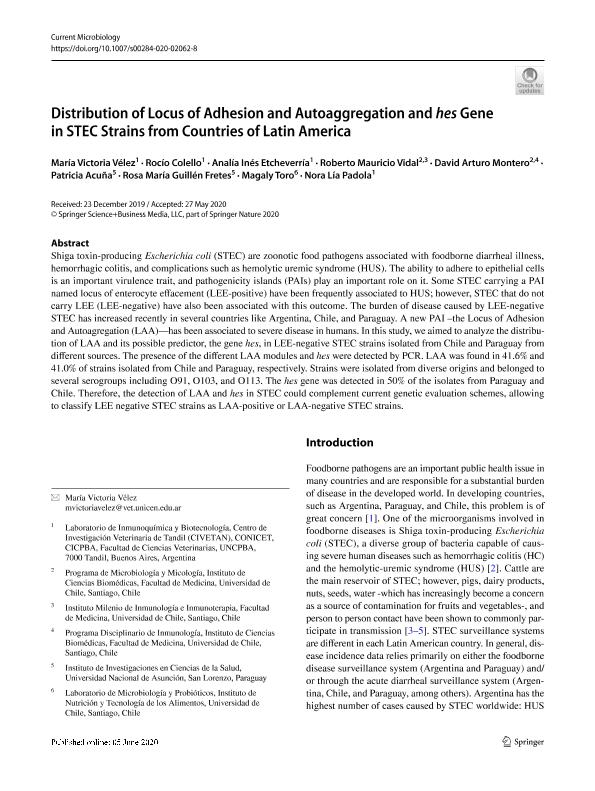Mostrar el registro sencillo del ítem
dc.contributor.author
Velez, Maria Victoria

dc.contributor.author
Colello, Rocío

dc.contributor.author
Etcheverría, Analía Inés

dc.contributor.author
Vidal, Roberto Mauricio
dc.contributor.author
Montero, David Arturo
dc.contributor.author
Acuña, Patricia
dc.contributor.author
Guillén Fretes, Rosa María
dc.contributor.author
Toro, Magaly
dc.contributor.author
Padola, Nora Lía

dc.date.available
2021-09-14T11:45:46Z
dc.date.issued
2020-06
dc.identifier.citation
Velez, Maria Victoria; Colello, Rocío; Etcheverría, Analía Inés; Vidal, Roberto Mauricio; Montero, David Arturo; et al.; Distribution of Locus of Adhesion and Autoaggregation and hes Gene in STEC Strains from Countries of Latin America; Springer; Current Microbiology; 77; 9; 6-2020; 2111-2117
dc.identifier.issn
0343-8651
dc.identifier.uri
http://hdl.handle.net/11336/140287
dc.description.abstract
Shiga toxin-producing Escherichia coli (STEC) are zoonotic food pathogens associated with foodborne diarrheal illness, hemorrhagic colitis, and complications such as hemolytic uremic syndrome (HUS). The ability to adhere to epithelial cells is an important virulence trait, and pathogenicity islands (PAIs) play an important role on it. Some STEC carrying a PAI named locus of enterocyte effacement (LEE-positive) have been frequently associated to HUS; however, STEC that do not carry LEE (LEE-negative) have also been associated with this outcome. The burden of disease caused by LEE-negative STEC has increased recently in several countries like Argentina, Chile, and Paraguay. A new PAI –the Locus of Adhesion and Autoagregation (LAA)—has been associated to severe disease in humans. In this study, we aimed to analyze the distribution of LAA and its possible predictor, the gene hes, in LEE-negative STEC strains isolated from Chile and Paraguay from different sources. The presence of the different LAA modules and hes were detected by PCR. LAA was found in 41.6% and 41.0% of strains isolated from Chile and Paraguay, respectively. Strains were isolated from diverse origins and belonged to several serogroups including O91, O103, and O113. The hes gene was detected in 50% of the isolates from Paraguay and Chile. Therefore, the detection of LAA and hes in STEC could complement current genetic evaluation schemes, allowing to classify LEE negative STEC strains as LAA-positive or LAA-negative STEC strains.
dc.format
application/pdf
dc.language.iso
eng
dc.publisher
Springer

dc.rights
info:eu-repo/semantics/openAccess
dc.rights.uri
https://creativecommons.org/licenses/by-nc-sa/2.5/ar/
dc.subject
LOCUS OF ADHESION AND AUTOAGGREGATION
dc.subject
HES
dc.subject
STEC
dc.subject
LATIN AMERICA
dc.subject.classification
Otras Ciencias Veterinarias

dc.subject.classification
Ciencias Veterinarias

dc.subject.classification
CIENCIAS AGRÍCOLAS

dc.title
Distribution of Locus of Adhesion and Autoaggregation and hes Gene in STEC Strains from Countries of Latin America
dc.type
info:eu-repo/semantics/article
dc.type
info:ar-repo/semantics/artículo
dc.type
info:eu-repo/semantics/publishedVersion
dc.date.updated
2021-09-07T14:29:01Z
dc.journal.volume
77
dc.journal.number
9
dc.journal.pagination
2111-2117
dc.journal.pais
Alemania

dc.journal.ciudad
Berlin
dc.description.fil
Fil: Velez, Maria Victoria. Consejo Nacional de Investigaciones Científicas y Técnicas. Centro Científico Tecnológico Conicet - Tandil. Centro de Investigación Veterinaria de Tandil. Universidad Nacional del Centro de la Provincia de Buenos Aires. Centro de Investigación Veterinaria de Tandil. Provincia de Buenos Aires. Gobernación. Comision de Investigaciones Científicas. Centro de Investigación Veterinaria de Tandil; Argentina
dc.description.fil
Fil: Colello, Rocío. Consejo Nacional de Investigaciones Científicas y Técnicas. Centro Científico Tecnológico Conicet - Tandil. Centro de Investigación Veterinaria de Tandil. Universidad Nacional del Centro de la Provincia de Buenos Aires. Centro de Investigación Veterinaria de Tandil. Provincia de Buenos Aires. Gobernación. Comision de Investigaciones Científicas. Centro de Investigación Veterinaria de Tandil; Argentina
dc.description.fil
Fil: Etcheverría, Analía Inés. Consejo Nacional de Investigaciones Científicas y Técnicas. Centro Científico Tecnológico Conicet - Tandil. Centro de Investigación Veterinaria de Tandil. Universidad Nacional del Centro de la Provincia de Buenos Aires. Centro de Investigación Veterinaria de Tandil. Provincia de Buenos Aires. Gobernación. Comision de Investigaciones Científicas. Centro de Investigación Veterinaria de Tandil; Argentina
dc.description.fil
Fil: Vidal, Roberto Mauricio. Universidad de Chile; Chile
dc.description.fil
Fil: Montero, David Arturo. Universidad de Chile; Chile
dc.description.fil
Fil: Acuña, Patricia. Universidad Nacional de Asunción; Paraguay
dc.description.fil
Fil: Guillén Fretes, Rosa María. Universidad Nacional de Asunción; Paraguay
dc.description.fil
Fil: Toro, Magaly. Universidad de Chile; Chile
dc.description.fil
Fil: Padola, Nora Lía. Consejo Nacional de Investigaciones Científicas y Técnicas. Centro Científico Tecnológico Conicet - Tandil. Centro de Investigación Veterinaria de Tandil. Universidad Nacional del Centro de la Provincia de Buenos Aires. Centro de Investigación Veterinaria de Tandil. Provincia de Buenos Aires. Gobernación. Comision de Investigaciones Científicas. Centro de Investigación Veterinaria de Tandil; Argentina
dc.journal.title
Current Microbiology

dc.relation.alternativeid
info:eu-repo/semantics/altIdentifier/url/http://link.springer.com/10.1007/s00284-020-02062-8
dc.relation.alternativeid
info:eu-repo/semantics/altIdentifier/doi/http://dx.doi.org/10.1007/s00284-020-02062-8
Archivos asociados
